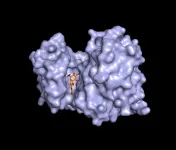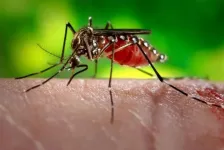(Press-News.org) Large galaxies are known to strip the gas that occupies the space between the stars of smaller satellite galaxies.
In research published today, astronomers have discovered that these small satellite galaxies also contain less 'molecular' gas at their centres.
Molecular gas is found in giant clouds in the centres of galaxies and is the building material for new stars. Large galaxies are therefore stealing the material that their smaller counterparts need to form new stars.
Lead author Dr Adam Stevens is an astrophysicist based at UWA working for the International Centre for Radio Astronomy Research (ICRAR) and affiliated to the ARC Centre of Excellence in All Sky Astrophysics in 3 Dimensions (ASTRO 3D).
Dr Stevens said the study provides new systematic evidence that small galaxies everywhere lose some of their molecular gas when they get close to a larger galaxy and its surrounding hot gas halo.
"Gas is the lifeblood of a galaxy," he said.
"Continuing to acquire gas is how galaxies grow and form stars. Without it, galaxies stagnate.
"We've known for a long time that big galaxies strip 'atomic' gas from the outskirts of small galaxies.
"But, until now, it hadn't been tested with molecular gas in the same detail."
ICRAR-UWA astronomer Associate Professor Barbara Catinella said galaxies don't typically live in isolation.
"Most galaxies have friends," she says.
"And when a galaxy moves through the hot intergalactic medium or galaxy halo, some of the cold gas in the galaxy is stripped away.
"This fast-acting process is known as ram pressure stripping."
The research was a global collaboration involving scientists from the University of Maryland, Max Planck Institute for Astronomy, University of Heidelberg, Harvard-Smithsonian Center for Astrophysics, University of Bologna and Massachusetts Institute of Technology.
Molecular gas is very difficult to detect directly.
The research team took a state-of-the-art cosmological simulation and made direct predictions for the amount of atomic and molecular gas that should be observed by specific surveys on the Arecibo telescope in Puerto Rico and the IRAM 30-meter telescope in Spain.
They then took the actual observations from the telescopes and compared them to their original predictions.
The two were remarkably close.
Associate Professor Catinella, who led the Arecibo survey of atomic gas, says the IRAM 30-meter telescope observed the molecular gas in more than 500 galaxies.
"These are the deepest observations and largest sample of atomic and molecular gas in the local Universe," she says.
"That's why it was the best sample to do this analysis."
The team's finding fits with previous evidence that suggests satellite galaxies have lower star formation rates.
Dr Stevens said stripped gas initially goes into the space around the larger galaxy.
"That may end up eventually raining down onto the bigger galaxy, or it might end up just staying out in its surroundings," he said.
But in most cases, the little galaxy is doomed to merge with the larger one anyway.
"Often they only survive for one to two billion years and then they'll end up merging with the central one," Dr Stevens said.
"So it affects how much gas they've got by the time they merge, which then will affect the evolution of the big system as well.
"Once galaxies get big enough, they start to rely on getting more matter from the cannibalism of smaller galaxies."
INFORMATION:
FAYETTEVILLE, Ark. - Cold temperatures, prevalent during glacial periods, had a significant impact on past and modern unglaciated landscapes across much of North America, according to a recent study by University of Arkansas geologist Jill A. Marshall.
Marshall, assistant professor of geosciences, is the first author of the study, published in the journal Geophysical Research Letters.
The findings help shape understanding of the earth's "Critical Zone," the relatively thin layer of the planet that extends from where vegetation meets the atmosphere to the lowermost extent of weathered bedrock. "Climate and ecosystems determine how quickly bedrock ...
DALLAS - Feb. 22, 2021 - Three decades-old antibiotics administered together can block a type of pain triggered by nerve damage in an animal model, UT Southwestern researchers report. The finding, published online today in PNAS, could offer an alternative to opioid-based painkillers, addictive prescription medications that are responsible for an epidemic of abuse in the U.S.
Over 100 million Americans are affected by chronic pain, and a quarter of these experience pain on a daily basis, a burden that costs an estimated $600 billion in lost wages and medical expenses ...
Scientists have identified a way to "rescue" muscle cells that have genetically mutated, paving the way to a possible new treatment for rare childhood illness such as Duchenne Muscular Dystrophy (DMD).
The study, led by the Universities of Exeter and Nottingham, is published in the Proceedings of the National Academies of Sciences, USA. The research used novel drugs being developed at the University of Exeter, which "metabolically reprogram" the cellular energy production centres in muscle cells, by providing them with a fuel source to generate metabolic energy.
DMD is a genetic condition caused by a mutation in a gene called dystrophin which results in progressive irreversible muscular degeneration and weakening. Its symptoms include muscle ...
Things just got hairy at Princeton.
Researchers found they could coat a liquid elastic on the outside of a disc and spin it to form useful, complex patterns. When spun just right, tiny spindles rise from the material as it cures. The spindles grow as the disc accelerates, forming a soft solid that resembles hairs.
Inspired by biological designs and rationalized with mathematical precision, the new method could be used at an industrial scale for production with plastics, glasses, metals and smart materials.
The researchers published their findings ...
(Boston)--Tau is a protein that helps stabilize the internal skeleton of nerve cells (neurons) in the brain. Groups of toxic tau protein, termed tau oligomers, drive disease progression and memory loss in Alzheimer's disease (AD). A new study from Boston University School of Medicine (BUSM) shows how these tau oligomers form, and, correspondingly, how they can be prevented.
AD is a major cause of disease in the elderly and places a huge financial cost on the health care system. Scientists have known for a long time that two proteins (?-amyloid and tau) clump and accumulate in the brains ...
LOGAN, UTAH, USA -- You might not like mosquitoes, but they like you, says Utah State University biologist Norah Saarman. And where you lead, they will follow.
In addition to annoying bites and buzzing, some mosquitoes carry harmful diseases. Aedes aegypti, the so-called Yellow Fever mosquito and the subject of a recent study by Saarman and colleagues, is the primary vector for transmission of viruses causing dengue fever, chikungunya and Zika, as well as yellow fever, in humans.
"Aedes aegypti is an invasive species to North America that's become widespread in the eastern United States," says Saarman, assistant professor in USU's Department of Biology and the USU Ecology Center, whose research focuses ...
Adolescents and teens may be more likely to be bullied by their friends -- and friends-of-friends -- than classmates they don't know as well, according to a new study.
Diane Felmlee, Distinguished Professor of Sociology and Demography at Penn State and researcher on the paper, said the findings give new insight into how and why bullying occurs -- important information for anti-bullying efforts.
"People often assume that bullying occurs between relative strangers, or that it targets those on the fringes of the social network," Felmlee said. "Those do occur, but in our study, we find that the rate of peer aggression is significantly higher between those students who are closely linked. Furthermore, our finding is not due to friends simply spending ...
In a new study out of University of California San Diego School of Medicine, researchers have identified a universal strain of bacteria derived from healthy human skin that can treat the most common type of eczema, also known as atopic dermatitis.
In the paper published Feb. 22, 2021, in Nature Medicine, the research team investigated the safety and mechanisms of this certain bacteria in a first-in-human, Phase I, double-blinded clinical trial looking to treat people living with eczema. Of the 54 participants, two-thirds reported improvements in their ...
The diversity and numbers of wild salmon in Northern B.C. have declined approximately 70 per cent over the past century, according to a new Simon Fraser University study.
Researchers drawing on 100-year-old salmon scales report that recent numbers of wild adult sockeye salmon returning to the Skeena River are 70 per cent lower than 100 years ago. Wild salmon diversity in the Skeena watershed has similarly declined by 70 per cent over the last century.
The research undertaken by Simon Fraser University (SFU) and Fisheries and Oceans Canada was published today in the Journal of Applied Ecology.
The research team applied modern genetic tools to salmon scales collected from commercial ...
Boston, Mass. - Even with more than 1.5 million Americans receiving a COVID vaccine each day, officials estimate it will take many more months before enough people are protected from the deadly virus. Until then, and potentially beyond, experts agree that opening up schools, restaurants and other public places as safely as possible will rely on widespread testing for SARS-CoV-2, the virus that causes COVID-19.
As of June 2020, the U.S. Food and Drug Administration (FDA) had granted emergency use authorization for more than 85 different viral DNA test kits -- or assays -- each with widely varying degrees of sensitivity and unknown rates of accuracy. However, with no existing gold standard test for the novel coronavirus, there's little data on which ...




